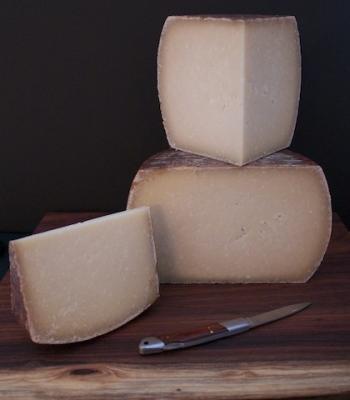Fiore Sardo
- Producer
- Various
- Country
- Italy
- Region
- Sardinia
- Size
- Drum
- Weight
- 6-7 lbs
- Website
- Milk
- Sheep
- Classification
- Hard
- Rennet
- Animal
- Rind
- Smoked

Sometimes referred to as Pecorino Sardo, Fiore Sardo is produced on the island of Sardinia off the coast of Italy. This is a cheese with very ancient origins, thought by some to date back to the Bronze Age. Partly as a result of this, Fiore Sardo was awarded DOP (name protected) status in 1996. Although there are now industrially produced variations of Fiore Sardo that are sometimes made from a blend of cow's and sheep's milk or even pasteurized milk, traditionally Fiore Sardo is made from fresh, unpasteurized sheep's milk, sourced from native Sardinian sheep from a single flock. These versions are made in small mountain huts - known as "pinnette" - by the shepherds that look after these flocks. The natural smoke from the hut's central, open fires give these cheeses their characteristically smoky overtones. For production, raw milk from one milking is poured into a cheese vat. (Originally, the shepherds would have used a wooden tub and the vat is the only concession to modern technology.) The milk is coagulated with animal rennet and the soft curd cut with a knife called a "chinova". The curd is left to drain and then cut again with a special knife known as a "sa sega casu". At this point, the curd is transferred to cheese molds, each one officially described as "two truncated cones joined at their wider base, whose diameter is inferior to the diameter of the cheese in its center". The molds containing the cheeses are briefly immersed in hot water to help develop the thick outer rind. They are then unmolded and placed in a brine solution. After removal from the brine, the cheeses are placed on a trellis-type mat made of rushes which is suspended in the smoky area above the fireplace in the mountain hut. The second stage of maturation takes place when the wheels are transferred to a platform in the roof before finally being finished in an underground cellar for the last stages of maturation. In the cellar, the wheels are periodically turned (flipped) and greased with olive oil to prevent the rind cracking. Cheeses are matured for between two and eight months before release. The texture of the outer rind of Fiore Sardo is dry and hard and, depending on age, a pale golden-rust color or a deep rich burnt brown. The texture of the cheese is very firm and dense and straw-ivory in color. Flavors are sweet, rich and nut-like with notes of burned caramel, smoke and salt.



